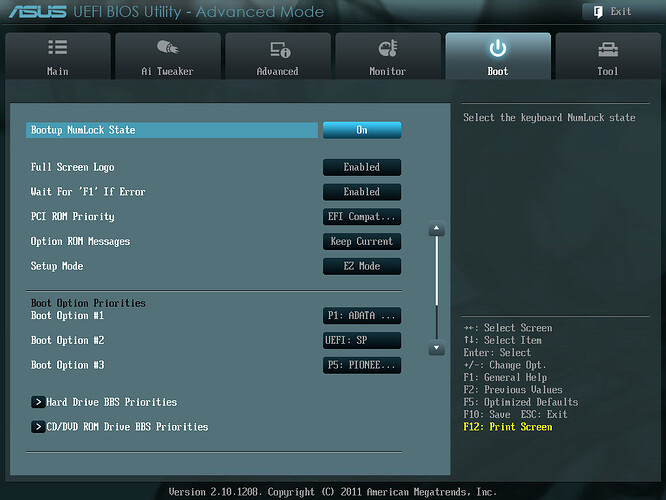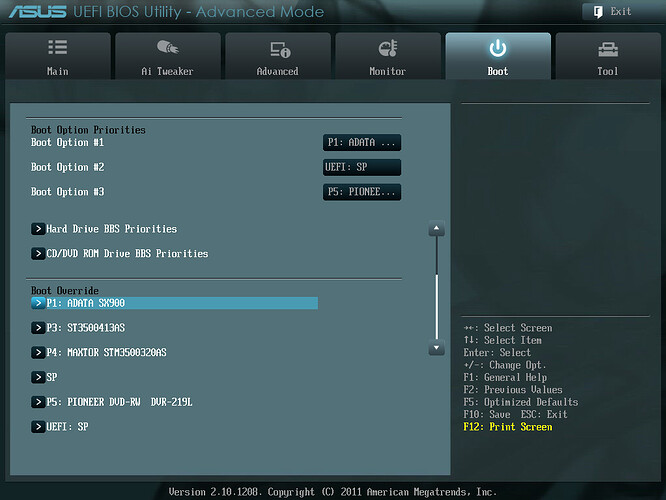Hi all friends.
is any way to enable fastboot option in P8P67 mainboard bios ?
Look into the "BOOT" section of the Enhanced BIOS Options. If you don’t find the option, please post a screenshot of the "BOOT" part of the BIOS.
If you have a RAID array, you should install the OS in UEFI mode and let the Intel SATA RAID Controller use the EFI SataDriver instead of the Intel RAID ROM module.
Look into the "BOOT" section of the Enhanced BIOS Options. If you don’t find the option, please post a screenshot of the "BOOT" part of the BIOS.
If you have a RAID array, you should install the OS in UEFI mode and let the Intel SATA RAID Controller use the EFI SataDriver instead of the Intel RAID ROM module.
Thanks for replay
here is the screenshot from BIOS BOOT menu. I dont have RAID but I use ADATA SX900 64GB SSD & I update latest Intel Sata EFI ROM in bios ( 13.1.0.2126 )
@ ErfanDL:
Thanks for the screenshots, which verify, that your BIOS doesn’t fully support an UEFI mode OS installation.
Which OS are you running and how did you install it?
As long as you have set the Intel SATA Controller to "AHCI", the Intel RAID modules within the BIOS (Intel RAID ROM resp. SataDriver) don’t matter - they are not used by your system.
As long as you have set the Intel SATA Controller to "AHCI", the Intel RAID modules within the BIOS (Intel RAID ROM resp. SataDriver) don’t matter - they are not used by your system.
My OS is Windows 7 Ultimate SP1 X64 and I install it with Rufus USB Flash bootable tools.
Which partition table (MBR or GPT) did you choose, when you started the creation of the bootable USB flash drive, and which bootable device did you choose at the beginning of the OS installation? Has the word "UEFI" been the praefix of the USB flash drive name?
Which partition table (MBR or GPT) did you choose, when you started the creation of the bootable USB flash drive, and which bootable device did you choose at the beginning of the OS installation? Has the word "UEFI" been the praefix of the USB flash drive name?
my choose is "MBR Partition scheme for BIOS or UEFI Computers" and screenshot from rufus:
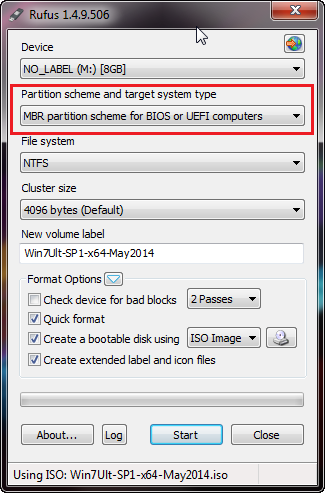
yes I see UEFI from USB bootable but when I choose UEFI Installition my pc restarting and cant go to OS installition
If you want a fast boot, you have to install the OS in UEFI mode, but maybe your P67 manboard doesn’t support it.
By the way: This is the Partition scheme you have to choose, if you want to get Win7 or Win8 installed in UEFI mode:
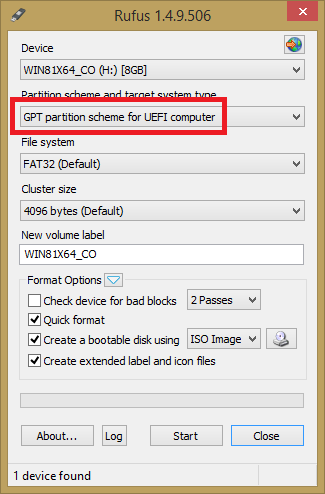
If you want a fast boot, you have to install the OS in UEFI mode, but maybe your P67 manboard doesn’t support it.
By the way: This is the Partition scheme you have to choose, if you want to get Win7 or Win8 installed in UEFI mode:
<img src=‘http://files.homepagemodules.de/b602300/f16t417p6530n2-thumb.png’alt=’’ style='border:none; ’ />
thanks fernando.
I test it and report
@Fernando
today I make Windows 7 bootable usb with rufus "GPT Partition Scheme for UEFI computer" but when I select UEFI installation show this error message:
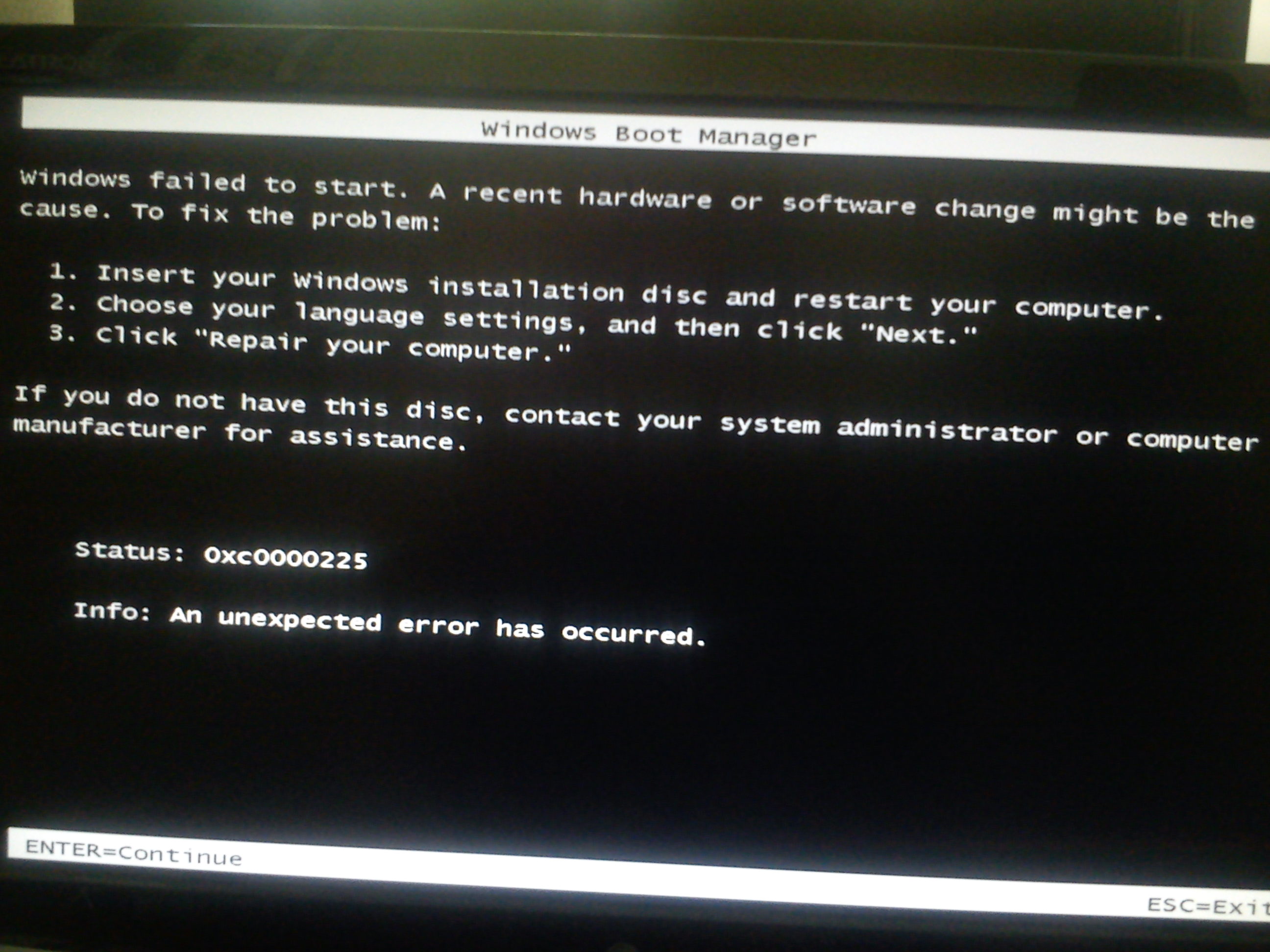
It seems, that you either have not done the required settings within the "BOOT" section of the BIOS or that your system does not support the UEFI mode OS installation.
Questions:
1. Are you running your Intel SATA Controller in AHCI or RAID mode? If it is RAID, is there a SataDriver module within the BIOS?
2. Do you have a discrete graphics card or the iGPU running? Is there a GopDriver present (either within the mainboard BIOS or within the graphics card BIOS)?
It seems, that you either have not done the required settings within the "BOOT" section of the BIOS or that your system does not support the UEFI mode OS installation.
Questions:
1. Are you running your Intel SATA Controller in AHCI or RAID mode? If it is RAID, is there a SataDriver module within the BIOS?
2. Do you have a discrete graphics card or the iGPU running? Is there a GopDriver present (either within the mainboard BIOS or within the graphics card BIOS)?
1. I use intel ahci mod on intel sata 3.0 port. I dont have any raid drives
2. I have asus 5850 vga card.
Ok, then the SataDriver module may be dispensable.
It should have a BIOS, which includes a suitable GopDriver.
Alternatively you can remove the graphics card and test the OS installation in UEFI mode by using the CPU integrated iGPU, but this requires a suitable Ivy/Sandy Bridge GopDriver within the mainboard BIOS.
Ok, then the SataDriver module may be dispensable.
It should have a BIOS, which includes a suitable GopDriver.
Alternatively you can remove the graphics card and test the OS installation in UEFI mode by using the CPU integrated iGPU, but this requires a suitable Ivy/Sandy Bridge GopDriver within the mainboard BIOS.
@fernando
My mainboard haven’t onboard vga output.
Are you sure about that? I thought, that all Intel 6-Series desktop mainboards have a CPU integrated graphics adapter.
Are you sure about that? I thought, that all Intel 6-Series desktop mainboards have a CPU integrated graphics adapter.
Yes i sure. My mainboard is asus p8p67. product link: http://www.asus.com/Motherboards/P8P67/specifications/
I am pretty sure, that your mainboard has been designed for the 2nd generation of the Intel(R) Core Processor Family (Sandy Bridge), which has an integrated GPU.
I am pretty sure, that your mainboard has been designed for the 2nd generation of the Intel(R) Core Processor Family (Sandy Bridge), which has an integrated GPU.
@Fernando
Thanks fernando for helping me.
I think must buy new motherboard
@Fernando
Hi fernando. today I found ( Launch EFI Shell from filesystem device ) in my BIOS menu. here is screenshots:
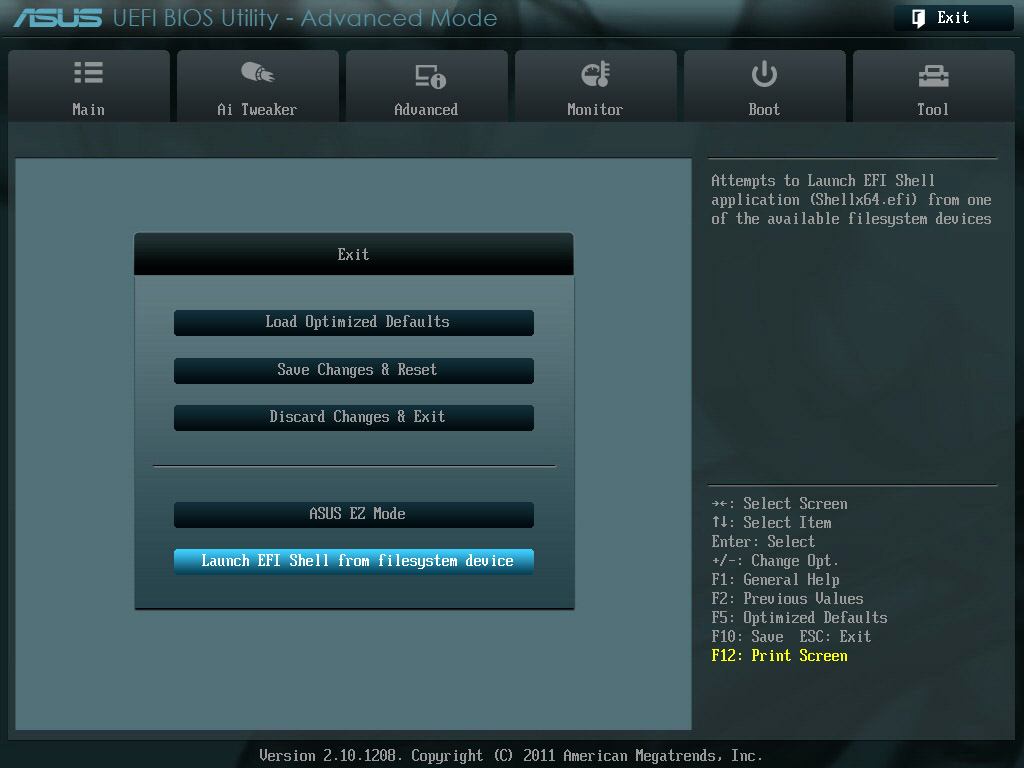
Can I install windows 7 in UEFI mod with this option ? is there anyway ?
AFAIK only the 64bit version of Windows 7 supports the UEFI installation.
The BIOS option "Launch EFI Shell from filesystem device" will search for a file named shellx64.efi, which should be within the bootable Windows 7 x64 image (DVD or USB flash drive).
For details you may look >here<.
